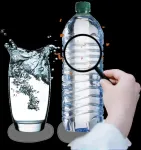(Press-News.org) A new paper by a team of Concordia researchers from the departments of Biology and Physics proposes a novel method of fighting cancer tumours that uses ultrasound-guided microbubbles — a technology already widely used in medical imaging and drug delivery.
Writing in the journal Frontiers in Immunology, the researchers describe a process that uses ultrasound to modify the behaviour of cancer-fighting T cells by increasing their cell permeability. They examined how this can influence the release of more than 90 kinds of cytokines, a type of signalling molecule crucial for immune response.
The researchers targeted freshly isolated human immune cells with tightly focused ultrasound beams and clinically approved contrast agent microbubbles. When hit with the ultrasound, the bubbles vibrate at extremely high frequency, acting as a push-pull on the walls of the T cell’s membranes. This can mimic the T cell’s natural response to the presence of an antigen. The T cell then begins to secrete vital signalling molecules that would otherwise be restricted by the tumour’s hostile microenvironment. The process does not damage the cell itself.
“We’re combining the use of ultrasound and microbubbles to help modulate brain immunology with the emerging field of cancer immunotherapy, which is the harnessing of our own immune cells to fight cancer,” says Brandon Helfield, an associate professor of biology and physics and the paper’s supervising author.
Reactivating cells
This approach directly confronts one of the major challenges to the body’s natural response to cancer: the tumour’s ability to deactivate T cells from producing cytokines and other proteins of interest once they enter the tumour itself.
“The microbubbles can re-activate the cells that have been turned off inside the tumour,” says the paper’s lead author, PhD candidate Ana Baez. “This process will help them release the proteins that are needed to grow additional immune and blood cells, which creates a positive feedback loop.”
The changes to cytokine secretion were found to be time dependent. The amount of cytokines increased between 0.1 to 3.6 times compared to untreated cells over 48 hours. Additionally, the researchers noticed that when the ultrasound made the cell membranes more permeable, the amount of cytokines released generally went down.
While only preliminarily shown through benchtop experiments, the authors hope that this study will deepen their understanding of the different pathways chemicals in the body’s immune system use to fight cancer. At the same time, they believe this avenue of research will improve and complement existing cancer treatments and cellular therapies.
“We already use microbubbles clinically as image-guided tools,” says Helfield, Tier II Canada Research Chair in Molecular Biophysics in Human Health. “In the future, we could manipulate the beam to go from imaging to a therapeutic sequence. This would localize the effect on the T cells so you are only activating the ones where the beam is.”
“We may also be able to include cancer-fighting drugs that target the tumour in the treatment,” Baez adds. “The technique is completely non-invasive, so we can always repeat it.”
Davindra Singh, Stephanie He, Mehri Hajiaghayi, Fatemeh Gholizadeh and Peter Darlington contributed to this study.
This work was supported by the Canada Research Chairs Program, the Cancer Research Society and the Canadian Institutes of Health Research (CIHR).
Read the cited paper: “Immunomodulation of human T cells by microbubble-mediated focused ultrasound.”
END
Ultrasound-directed microbubbles could boost immune response against tumours, new Concordia research suggests
Ana Baez and Brandon Helfield believe their novel method of fighting cancer can stimulate critical cytokine secretion in T cells
2025-01-15
ELSE PRESS RELEASES FROM THIS DATE:
In small preliminary study, fearful pet dogs exhibited significantly different microbiomes and metabolic molecules to non-fearful dogs, suggesting the gut-brain axis might be involved in fear behavior
2025-01-15
In small preliminary study, fearful pet dogs exhibited significantly different microbiomes and metabolic molecules to non-fearful dogs, suggesting the gut-brain axis might be involved in fear behaviors
Article URL: https://journals.plos.org/plosone/article?id=10.1371/journal.pone.0315374
Article title: Altered microbiome and metabolome profiling in fearful companion dogs: An exploratory study
Author countries: Italy
Funding: The author(s) received no specific funding for this work. END ...
Examination of Large Language Model "red-teaming" defines it as a non-malicious team-effort activity to seek LLMs' limits and identifies 35 different techniques used to test them
2025-01-15
Examination of Large Language Model "red-teaming" defines it as a non-malicious team-effort activity to seek LLMs' limits and identifies 35 different techniques used to test them
Article URL: https://journals.plos.org/plosone/article?id=10.1371/journal.pone.0314658
Article title: Summon a demon and bind it: A grounded theory of LLM red teaming
Author countries: US, Denmark
Funding: VILLUM Foundation, grant No. 37176: ATTiKA: Adaptive Tools for Technical Knowledge Acquisition. The funders had no role in study design, data collection ...
Most microplastics in French bottled and tap water are smaller than 20 µm - fine enough to pass into blood and organs, but below the EU-recommended detection limit
2025-01-15
Most microplastics in French bottled and tap water are smaller than 20 µm - fine enough to pass into blood and organs, but below the EU-recommended detection limit for water quality assessments.
####
Article URL: https://journals.plos.org/water/article?id=10.1371/journal.pwat.0000250
Article Title: Majority of potable water microplastics are smaller than the 20 μm EU methodology limit for consumable water quality
Author Countries: Denmark, France
Funding: This work and the PhD fellowship of O.H. is funded by an 80Prime CNRS grant «4DμPlast» (G.L.R, J.E.S.). This publication was supported by ANR-20-CE34-0014 ATMO-PLASTIC (G.L.R, J.E.S.) and the Plasticopyr ...
A tangled web: Fossil fuel energy, plastics, and agrichemicals discourse on X/Twitter
2025-01-15
An analysis of the nine top players in the U.S. fossil fuel-derived hydrocarbon industries (oil/gas, plastics, and agrichemicals) shows tight linkages across the three different sectors, with news media, other petrochemical industry players, and politicians also frequently tagged, according to a study published January 15, 2025 in the open-access journal PLOS Climate by Alaina Kinol from Northeastern University, United States, and colleagues.
Previous research on connections between the fossil fuel and plastics sectors and ...
This fast and agile robotic insect could someday aid in mechanical pollination
2025-01-15
CAMBRIDGE, MA — With a more efficient method for artificial pollination, farmers in the future could grow fruits and vegetables inside multilevel warehouses, boosting yields while mitigating some of agriculture’s harmful impacts on the environment.
To help make this idea a reality, MIT researchers are developing robotic insects that could someday swarm out of mechanical hives to rapidly perform precise pollination. However, even the best bug-sized robots are no match for natural pollinators like bees when it comes to endurance, speed, and maneuverability.
Now, inspired by the anatomy of these natural pollinators, the researchers ...
Researchers identify novel immune cells that may worsen asthma
2025-01-15
Hamilton, ON (January 15, 2025) – Researchers at McMaster University have made an important discovery in the field of asthma research, identifying a new population of immune cells that may play a crucial role in the severity of asthma symptoms.
The study, published in Science Translational Medicine on Jan. 15, 2025, sheds light on the complex mechanisms behind severe asthma and opens new avenues for potential treatments.
Asthma is a chronic respiratory condition characterized by inflammation and narrowing of the airways, leading to difficulty breathing. Severe ...
Conquest of Asia and Europe by snow leopards during the last Ice Ages uncovered
2025-01-15
The study, published in Science Advances, was led by researchers Qigao Jiangzuo, from Peking University, and Joan Madurell Malapeira, from the Universitat Autònoma de Barcelona (UAB).
Snow leopards (Panthera uncia) are in serious danger of extinction, with only about 4,000 specimens remaining. They are medium to large felids that live at high altitudes, over 2,000 meters above sea level, mainly in the Himalayas. Although their distinctive traits have long been recognized, the correlation between these ...
Researchers make comfortable materials that generate power when worn
2025-01-15
Researchers have demonstrated new wearable technologies that both generate electricity from human movement and improve the comfort of the technology for the people wearing them. The work stems from an advanced understanding of materials that increase comfort in textiles and produce electricity when they rub against another surface.
At issue are molecules called amphiphiles, which are often used in consumer products to reduce friction against human skin. For example, amphiphiles are often incorporated into diapers to prevent chafing.
“We set out to develop a model that would give us ...
Study finding Xenon gas could protect against Alzheimer’s disease leads to start of clinical trial
2025-01-15
Most treatments being pursued today to protect against Alzheimer’s disease focus on amyloid plaques and tau tangles that accumulate in the brain, but new research from Mass General Brigham and Washington University School of Medicine in St. Louis points to a novel—and noble—approach: using Xenon gas. The study found that Xenon gas inhalation suppressed neuroinflammation, reduced brain atrophy, and increased protective neuronal states in mouse models of Alzheimer’s disease. Results are published in Science Translational Medicine, and a phase 1 clinical trial of the treatment in healthy volunteers will begin in early 2025.
“It ...
Protein protects biological nitrogen fixation from oxidative stress
2025-01-15
A small helper for big tasks: an oxygen sensor protein protects the enzymatic machinery of biological nitrogen fixation from serious damage. Its use in biotechnology could help to reduce the use of synthetic fertiliser in agriculture in the future. A research team led by biochemist Prof. Dr Oliver Einsle from the Faculty of Chemistry and Pharmacy and the Centre for Biological Signalling Studies (BIOSS) at the University of Freiburg has discovered exactly how the so-called Shethna protein II works. The scientists used the newly established cryo-electron microscopy in Freiburg. ...
LAST 30 PRESS RELEASES:
Oldest modern shark mega-predator swam off Australia during the age of dinosaurs
Scientists unveil mechanism behind greener ammonia production
Sharper, straighter, stiffer, stronger: Male green hermit hummingbirds have bills evolved for fighting
Nationwide awards honor local students and school leaders championing heart, brain health
Epigenetic changes regulate gene expression, but what regulates epigenetics?
Nasal drops fight brain tumors noninvasively
Okayama University of Science Ranked in the “THE World University Rankings 2026” for the Second Consecutive Year
New study looks at (rainforest) tea leaves to predict fate of tropical forests
When trade routes shift, so do clouds: Florida State University researchers uncover ripple effects of new global shipping regulations
Kennesaw State assistant professor receives grant to improve shelf life of peptide- and protein-based drugs
Current heart attack screening tools are not optimal and fail to identify half the people who are at risk
LJI scientists discover how T cells transform to defend our organs
Brain circuit controlling compulsive behavior mapped
Atoms passing through walls: Quantum tunneling of hydrogen within palladium crystal
Observing quantum footballs blown up by laser kicks
Immune cells ‘caught in the act’ could spur earlier detection and prevention of Type 1 Diabetes
New membrane sets record for separating hydrogen from CO2
Recharging the powerhouse of the cell
University of Minnesota research finds reducing inflammation may protect against early AMD-like vision loss
A mulching film that protects plants without pesticides or plastics
New study highlights key findings on lung cancer surveillance rates
Uniform reference system for lightweight construction methods
Improve diet and increase physical activity at the same time to limit weight gain, study suggests
A surprising insight may put a charge into faster muscle injury repair
Scientists uncover how COVID-19 variants outsmart the immune system
Some children’s tantrums can be seen in the brain, new study finds
Development of 1-Wh-class stacked lithium-air cells
UVA, military researchers seek better ways to identify, treat blast-related brain injuries
AMS Science Preview: Railways and cyclones; pinned clouds; weather warnings in wartime
Scientists identify a molecular switch to a painful side effect of chemotherapy
[Press-News.org] Ultrasound-directed microbubbles could boost immune response against tumours, new Concordia research suggestsAna Baez and Brandon Helfield believe their novel method of fighting cancer can stimulate critical cytokine secretion in T cells




